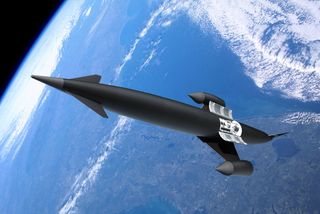Can Airplanes Fly into Outer Space?

The tricky thing is the Earth's gravity, which keeps today's standard aircraft out of space just as surely as it keeps you and me regrettably moored to the planet's surface.
According to NASA, any vehicle hoping launch into orbit has to travel about seven miles per second (11 kps), or about 25,000 mph (40,000 kph). You're average sub-sonic airliner, of course, doesn't fly near that fast.
There's also fuel problem too. The shortest distance between Earth and space is about 62 miles (100 kilometers) straight up, which by general accord is where the planet's boundary ends and suborbital space begins.
To reach orbit that way, NASA needs some 520,000 gallons of rocket propellant and two strap-on rocket boosters to loft a 100-ton space shuttle and its cargo into space in just under nine minutes. Flying horizontal, you can imagine, would require much more conventional fuel than an aircraft — or a space shuttle — could carry.
That being said, there are ways for aircraft-based vehicles to reach space. Aerospace designer Burt Rutan and his firm Scaled Composites built a suborbital rocket ship — SpaceShipOne — which they dropped from a high-altitude aircraft. Once clear, SpaceShipOne pilots aimed their vehicle skyward, ignited its rocket engine and reached suborbital space before gliding back to Earth.
The U.S. military's X-15 rocket planes, too, reached the edge of space in a similar manner and at least one firm, Oklahoma's Rocketplane Global, Inc. is hoping to refit a private jet airframe with rocket engines for tourism flights to suborbital space.
Follow Life's Little Mysteries on Twitter @llmysteries. We're also on Facebook & Google+.
Sign up for the Live Science daily newsletter now
Get the world’s most fascinating discoveries delivered straight to your inbox.

